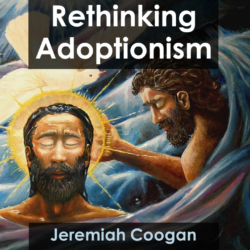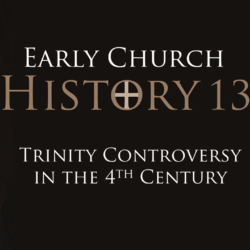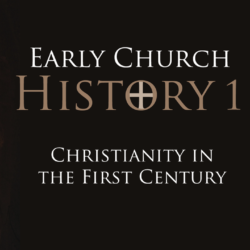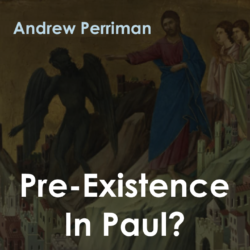This is part 14 of the Early Church History class.
We’ve been learning about the controversy over Christ’s origins in the last couple of episodes. This battle raged between groups of Christians who agreed that Jesus pre-existed for sixty years. But today we are taking a break from that and looking instead at the early Christians who held to a dynamic monarchian Christology. Specifically, we’ll consider two influential bishops: Paul of Samosata and Photinus of Sirmium. Although sometimes mislabeled as adoptionists, these two believed in the virgin birth but did not think Christ existed before then. Although what we know about these two survives in the writings of their enemies, we can reconstruct sketches of their beliefs and influence.
Listen to this episode on Spotify or Apple Podcasts
—— Links ——
- See other episodes featuring famous biblical unitarians: Thomas Emlyn, Michael Servetus, Adam Pastor, Claude of Savoy, Armenian Unitarians, Socinian Movement in Poland and Transylvania, British Unitarians
- More Restitutio resources on Christian history
- For the postscript discussion about the Constantinian Shift, see Preston Sprinkle’s book, Nonviolence (previously called Fight), and his interview with George Kalantzis as well as his book Caesar and the Lamb
- See other classes here
- Support Restitutio by donating here
- Join our Restitutio Facebook Group and follow Sean Finnegan on Twitter @RestitutioSF
- Leave a voice message via SpeakPipe with questions or comments and we may play them out on the air
- Intro music: Good Vibes by MBB Attribution-ShareAlike 3.0 Unported (CC BY-SA 3.0) Free Download / Stream: Music promoted by Audio Library.
- Who is Sean Finnegan? Read his bio here
—— Notes ——
Over the last couple of sessions, we’ve looked at the shameful battle between egalitarians and subordinationists. Both parties believed Jesus pre-existed but couldn’t agree on whether he was eternal and equal with the Father or not. However, at the same time, another stream of Christians fought for another view – a theology they thought was more biblical and less fraught with philosophical conundrums—the dynamic Monarchians.
Paul of Samosata’s Life (200-275)
- 260 – Ordained Bishop of Antioch
- 264 – Synod at Antioch
- 268 – Synod at Antioch, debate w/ Malchion
- 272 – Aurelian deposed Paul
Robert Lynn Sample: “Paul’s particular brand of Christianity had an ecstatic or spontaneous character, with a stress on spiritual power.”[1]
Artemon of Rome (fl. 230)
- Claimed that non-pre-existence dominated throughout the time of Bishop Victor of Rome (d. 199)
- Artemon taught that though Christ was born of a virgin, he was a “mere man”.
- Theodotus of Byzantium was Artemon’s predecessor.
Paul of Samosata’s Beliefs
- Lumped in with Artemon and Ebionites by Eusebius
- Epiphanius accused Paul of importing Judaism (though not circumcision or Sabbath observance).
- Paul said the logos was homoousios with the Father.
- The Son is what the logos became when it was made flesh.
- Christ did exist prophetically before he was born.
- Paulinians or Paulianists continued to hold a unitarian faith long after Paul died.
Photinus of Sirmium’s Life (d. 376)
- From Ancyra in Galatia
- 343 – Ordained Bishop of Sirmium
- 344 – Council at Antioch (Macrostitch Creed)
- 345 – Milan Council condemned him.
- 347 – Rome Council condemned him.
- 351 – After a debate, Constantius deposed him.
- 351 – Council at Sirmium denounced Photinian doctrine.
- 361 – Returned to Sirmium as Bishop
- 364 – Valentinian I deposed him.
Photinus’ Beliefs
- Jerome accused him of reviving the Ebionite heresy.
- Very biblical; quoted 1 Corinthians 15.47; 1 Timothy 2.5; John 8.40
- Christ only existed from Mary’s time when she conceived by the Holy Spirit.
- The Son did exist, but only according to foreknowledge or predestination.
- Photinians persisted in the Roman Empire for another 150 years.
Review
- From 260 – 272, Paul of Samosata was the bishop of Antioch, one of the four most important churches in the world.
- He was a charismatic preacher whose animated congregation participated with applauding, waving handkerchiefs, shouting, and even jumping.
- Paul prevented singing the newer hymns to Jesus, probably because they differed from his beliefs.
- Other bishops challenged him in 264 and tried to depose him in 268. Paul did not leave his church.
- In 272, Emperor Aurelian took back the region for Rome from Queen Zenobia of Palmyra and deposed Paul.
- Like Artemon a generation before him and Theodotus before him, Paul taught that Jesus was the Christ, but that he did not exist before his birth, though he agreed that he “existed prophetically.”
- Paul taught that the logos was of the same substance (homoousios) as the Father.
- Photinus was bishop of Sirmium in the middle of the fourth century until emperors Constantius and Valentinus I deposed him.
- Like Paul, he believed that the logos was “in the Father” but was not equivalent to the Son, though the Son is what the logos became when it became flesh.
- Photinus placed a heavy emphasis on scripture and said he had a hundred prooftexts for his Christology.
- After Photinus died, Photinians persisted in the Roman Empire for another century and a half in small pockets.
[1] Robert Lynn Sample, “The Messiah as Prophet: The Christology of Paul of Samosata,” PhD diss., Northwestern University, June 1977, 5.







Sean, have you done any podcasts on John Chrysostum (or included in one)? I would love to know more about him!
Thanks, Sean, for the lengthy reply to my question about just war and the stance of early Christians regarding military service/pacifism. You’re the best! I will check out those references, and that podcast you referenced sounds great. Will listen to it tomorrow.
This has been an excellent series, Sean; you pack a lot of information into every lesson. Regarding Paul of Samosata, is there a free, online copy of the dissertation by Robert Sample, which you cited?